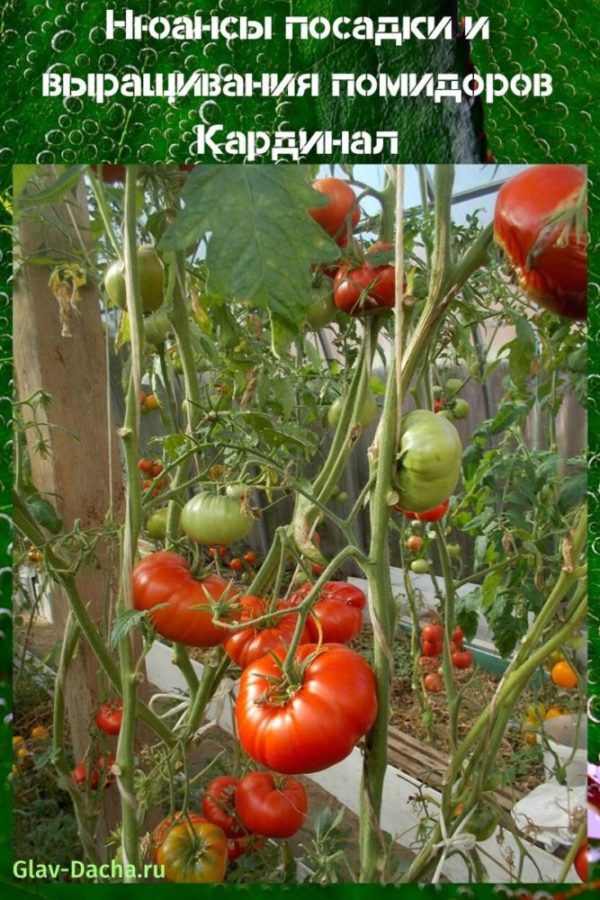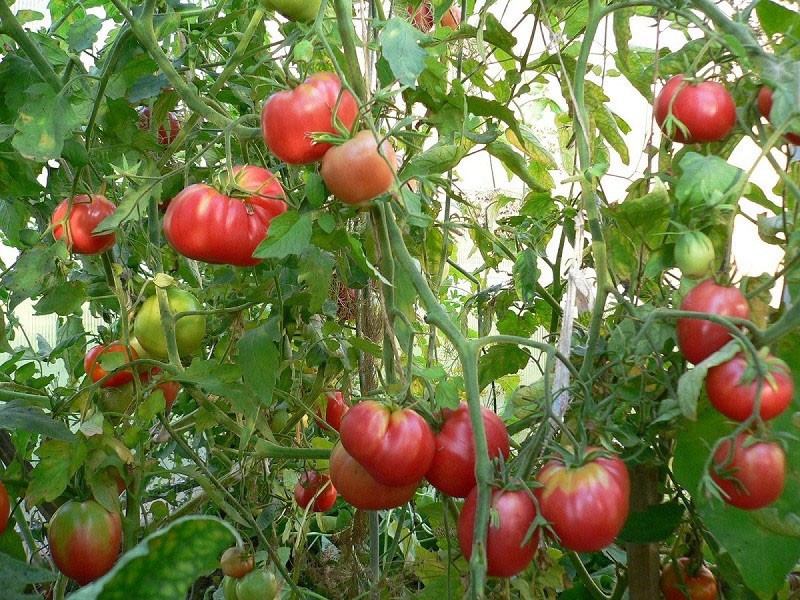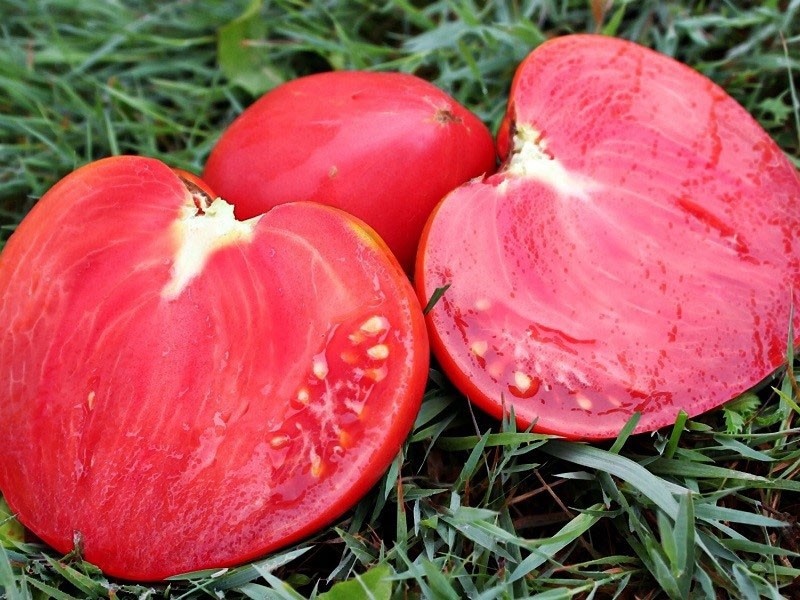The nuances of planting and growing Cardinal tomatoes
 Cardinal is one of the best mid-early tomato varieties, appreciated by gardeners for the juiciness, meatiness and attractiveness of the fruit. And the excellent taste of tomatoes allows you to use it fresh, in the preparation of salads, sauces, as well as in preparations for the winter. Proper cultivation of Cardinal tomatoes in compliance with all norms and recommendations will ensure a rich and high-quality harvest.
Cardinal is one of the best mid-early tomato varieties, appreciated by gardeners for the juiciness, meatiness and attractiveness of the fruit. And the excellent taste of tomatoes allows you to use it fresh, in the preparation of salads, sauces, as well as in preparations for the winter. Proper cultivation of Cardinal tomatoes in compliance with all norms and recommendations will ensure a rich and high-quality harvest.
Description and characteristics of Cardinal tomatoes
The variety was included in the State Register in 1998 after lengthy selection work by representatives of the Gisok company. It was named after Cardinal Giulio Mazarin, due to the fact that the conical shape of the fruit rather closely resembled the beard of a French rebel.
Characteristics and description of Cardinal tomatoes:
- A tall plant can reach over 1.5 m in height.
- Powerful core root system.
- Leaves are slightly corrugated, medium in size and light green in color.
- The laying of the first flowering brush begins after the formation of 8 leaves.
- The inflorescence is simple.
- On each branch, under favorable concomitant conditions, 5-6 fruits are laid.
- Heart-shaped fruits are large, weighing from 300 to 800 g, have a weak ribbing, thin pink skin and juicy, sugary pulp.
The fruits ripen gradually throughout the season. Subject to the conditions for growing Cardinal tomatoes in open areas, you can collect 4-5 kg of fruits from 1 bush.
Advantages and disadvantages of the Cardinal variety

Positive characteristics include:
- high yield rate;
- excellent presentation, large-fruited, meatiness and juiciness of tomatoes;
- fruits of the same size and shape;
- excellent taste;
- lack of tendency to cracking;
- a quick ripening period after picking vegetables from a bush;
- the possibility of using seeds for sowing seedlings in the next season.

For the correct cultivation of the Cardinal tomato, it is important to take into account the disadvantages of the variety.:
- bushes reach considerable heights and need a garter;
- low transportability and short shelf life of fruits.
The advantages of the variety exceed its disadvantages, this explains the popularity of Cardinal tomatoes among experienced gardeners.
Tomato cultivation technology Cardinal
 To grow a healthy, fruiting plant, you should create all the conditions for the active formation of seedlings and the growth of seedlings, and correctly design their planting in open ground.
To grow a healthy, fruiting plant, you should create all the conditions for the active formation of seedlings and the growth of seedlings, and correctly design their planting in open ground.
Sowing work should be planned for March. Transferring seedlings to open ground to begin in the last decade of May and early June.
Seed and soil preparation
 Before sowing, soak the seeds for 2 hours using a manganese solution, this will increase the seedlings' resistance to disease. Then rinse the seed with warm water.
Before sowing, soak the seeds for 2 hours using a manganese solution, this will increase the seedlings' resistance to disease. Then rinse the seed with warm water.
As a container for seedlings, you can take plastic containers, wooden boxes, peat pots. Prepare the soil from fertile soil, peat, mullein, combining them in equal parts. Enrich the resulting mixture with ash in an amount of 150 g, add 1 kg of sand and 35 g superphosphate based on 1 bucket of soil composition.
Growing conditions for seedlings
Fill planting containers with potting soil.Make grooves 1.5-2 cm deep and place the prepared seed in them. Maintain a distance of 2 cm between seeds in a row. Sprinkle with soil and moisten with warm water. Cover containers with plastic wrap and remove to a warm place.
To obtain strong seedlings, the temperature in the room should be +25 degrees, and the duration of daylight hours should be 10 hours.
 As soon as the sprouts appear, the film should be removed, and the containers should be rearranged in a well-lit place. If there is not enough light, you can use additional artificial sources.
As soon as the sprouts appear, the film should be removed, and the containers should be rearranged in a well-lit place. If there is not enough light, you can use additional artificial sources.
 When the second true leaf is formed, make a pick and move the most adapted sprouts into separate pots, water, apply mineral fertilizers and mulch. When watering, avoid stagnant moisture, as this can provoke rotting of the root system.
When the second true leaf is formed, make a pick and move the most adapted sprouts into separate pots, water, apply mineral fertilizers and mulch. When watering, avoid stagnant moisture, as this can provoke rotting of the root system.
Carry out the hardening procedure 2 weeks before the transplant. Periodically remove the plants to a cool place, provided there are no drafts.
Transplanting seedlings into open soil
 Transfer in the evening. This will allow the seedlings to acclimate to their new location. Soil temperature should be at least 12-15 ° С.
Transfer in the evening. This will allow the seedlings to acclimate to their new location. Soil temperature should be at least 12-15 ° С.
When choosing a place for a garden, avoid areas where it previously grew eggplant, peas, peppers, potatoes and tomatoes. The best predecessors are cabbage, onions, beans.
Technology for planting seedlings in open ground:
- Dig up the site, level and enrich with compost, wood ash, superphosphate.
- Make holes, keeping a distance of 30 cm, and between rows - 45-50 cm for good care and ease of harvesting.
- Place the peg in the center of the hole.
- Place the seedling in the groove, straighten the root system and cover with fertile soil.
- Tie the shoot to the peg.
- Pour well with warm water.
The yield of the culture depends on competently carried out care, therefore, tomato bushes need to be surrounded with attention and care.
Crop follow-up

Growing a Cardinal tomato provides for the following agrotechnical techniques:
- Water only with warm, settled water at intervals of 1 time in 7-10 days. Moisturize carefully, being careful not to expose additional roots that supply the powerful plant with nutrients. One bush should receive 5 liters of liquid.

- When leaving, it is important to remove weeds in a timely manner and loosen the soil at least 2-3 times a month. Be sure to pour mulch between the rows: straw, peat, humus.

- If necessary, tie up the plant throughout the entire growth period to the support installed during planting. In order not to have to lengthen or change it, you should select a long peg in advance.
- Trim the lower leaves and lateral shoots periodically, leaving only the two main stems.

- Cardinal tomatoes are responsive to feeding. During the growing season, you need to apply fertilizers 4 times: after planting, before flowering, during the formation of the first ovaries, at the time of fruiting.

It is better to take wood ash, mullein infusion, ammonium nitrate and superphosphate as nutrients for tomatoes.
Diseases and pests

Failure to comply with agrotechnical standards may cause:
- Aphids, slugs, whiteflies, spider mites, which provoke an arrest of growth, development of the bush, the absence of inflorescences and fruits. To fight, use chemical, as well as folk remedies.
- Late blight, black, brown, brown, white spot, bacterial cancer, for the treatment of which it is necessary to carry out treatment with fungicides.
Also, you can not do without preventive measures.:
- compliance with crop rotation;
- preventing the growth of weeds on the beds;
- providing ventilation, keeping a distance when planting seedlings;
- timely implementation of treatments for the prevention of copper-containing drugs.
When using chemicals, strictly adhere to the order prescribed in the instructions on the packaging of the preparations.
Large-fruited Cardinal tomatoes have always been a priority for gardeners, due to their high taste and marketability, and undemanding care. It is possible to increase the yield indicator and the saturation of the taste of the fruits, provided that all recommendations for growing a crop are observed.